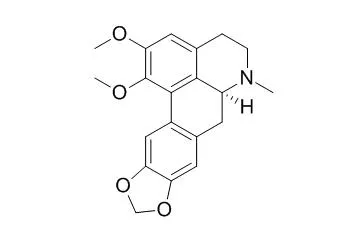| Kinase Assay: |
| J Enzyme Inhib Med Chem. 2011 Feb;26(1):46-55. | | Nantenine as an acetylcholinesterase inhibitor: SAR, enzyme kinetics and molecular modeling investigations.[Pubmed: 20583856] |
METHODS AND RESULTS:
Nantenine, as well as a number of flexible analogs, were evaluated for acetylcholinesterase (AChE) inhibitory activity in microplate spectrophotometric assays based on Ellman's method. It was found that the rigid aporphine core of Nantenine is an important structural requirement for its anticholinesterase activity. Nantenine showed mixed inhibition kinetics in enzyme assays. Molecular docking experiments suggest that Nantenine binds preferentially to the catalytic site of AChE but is also capable of interacting with the peripheral anionic site (PAS) of the enzyme, thus accounting for its mixed inhibition profile.
CONCLUSIONS:
The aporphine core of Nantenine may thus be a useful template for the design of novel PAS or dual-site AChE inhibitors. Inhibiting the PAS is desirable for prevention of aggregation of the amyloid peptide Aβ, a major causative factor in the progression of Alzheimer's disease (AD). |
|
| Animal Research: |
| Psychopharmacology (Berl). 2004 May;173(3-4):270-7. | | Nantenine: an antagonist of the behavioral and physiological effects of MDMA in mice.[Pubmed: 14740148 ] | No selective antagonists for the effects of MDMA have yet been identified. The structurally-similar, naturally-occurring plant alkaloid Nantenine (9,10-methylenedioxy-1,2 dimethoxyaporphine) may represent such a compound.
To investigate the capacity of Nantenine to block and/or reverse MDMA-induced hyperthermia, lethality, locomotor stimulation, and head twitches in mice, and to compare these actions with those of the selective alpha1 antagonist prazosin and the selective 5-HT2A antagonist M100907.
METHODS AND RESULTS:
Pretreatments of either 10 mg/kg Nantenine or 1 mg/kg prazosin were administered 15 min before 32 mg/kg MDMA; core temperature and locomotor stimulation were then monitored via radiotelemetry for at least 3 h. In further hyperthermia studies, 32 mg/kg MDMA was administered first and temperature was allowed to rise for 30 min; 10 mg/kg Nantenine, 1 mg/kg prazosin, or 1 mg/kg M100907 was then administered in an attempt to reverse MDMA-induced hyperthermia. In lethality assays, percent lethality was quantified 2 h after MDMA injection in two distinct housing conditions, one or 12 mice per cage, with or without 15 min pretreatments of 10 mg/kg Nantenine or 1 mg/kg prazosin. Drug elicited head twitches were quantified for 10 min following administration of either MDMA enantiomer, with and without pretreatments of 1 mg/kg Nantenine, 0.1 mg/kg prazosin, or 0.001 mg/kg M100907.
Nantenine blocked and rapidly reversed MDMA-induced hyperthermia, attenuated lethality in both housing conditions, and reduced MDMA-induced locomotor stimulation and head twitches in mice. Prazosin blocked, but did not reverse, MDMA-induced hyperthermia, attenuated lethality (more effectively in singly-housed animals), and reduced MDMA-induced locomotor stimulation and head twitches. M100907 did not reverse MDMA-induced hyperthermia, but effectively blocked drug-elicited head twitches.
CONCLUSIONS:
Nantenine functions as an effective antagonist against a wide range of MDMA-induced effects in mice. The antagonist actions of this compound at serotonin and adrenergic receptors may be differentially implicated across endpoints. |
|
| Structure Identification: |
| Bioorg Med Chem Lett. 2015 Sep 1;25(17):3451-4. | | C4 phenyl aporphines with selective h5-HT(2B) receptor affinity.[Pubmed: 26227772] |
METHODS AND RESULTS:
A group of aporphine alkaloids related to (±)-Nantenine (1) and bearing a C4 phenyl and various C1 or N-substituents, was synthesized and evaluated for affinity to h5-HT receptors. In general, unlike Nantenine, the analogs lack affinity for the h5-HT(2A) receptor and other 5-HT receptors but bind selectively to the h5-HT(2B) receptor. With regards to 5-HT(2B) affinity, there appears to be a low tolerance for bulky C1 or N-substituents when the C4 phenyl moiety is present.
CONCLUSIONS:
Compound 5a had the highest 5-HT(2B) affinity of the compounds tested, was found to be an antagonist and is selective vs other CNS receptors. | | Nat Prod Res. 2014;28(15):1159-64. | | A new alkaloid from the fruit of Nandina domestica Thunb.[Pubmed: 24897106 ] |
METHODS AND RESULTS:
A new steroidal alkaloid, (20S,22R,24R)-24-ethyl-3-oxocholest-4-en-22-amino, named as nandsterine (1), together with 10 known alkaloids, palmatine (2), O-methylbulbocapnine (3), Nantenine (4), dehydroNantenine (5), glaucine (6), didehydroglaucine (7), dehydrocorydaline (8), jatrorrhizine (9), magnoflorine (10) and berberine (11), was isolated from the fruit of Nandina domestica Thunb. Their structures were elucidated by using spectroscopic methods as well as by comparing with the published data.
CONCLUSIONS:
Compound 1 was a new class of steroidal alkaloid isolated from the family Berberidaceae, meanwhile compounds 2, 3, 6-8 and 10 were obtained from N. domestica for the first time. Compound 1 exhibited cytotoxicity against HL-60 cells (human leukaemia) with IC50 values of 52.1 uM. |
|






 Cell. 2018 Jan 11;172(1-2):249-261.e12. doi: 10.1016/j.cell.2017.12.019.IF=36.216(2019)
Cell. 2018 Jan 11;172(1-2):249-261.e12. doi: 10.1016/j.cell.2017.12.019.IF=36.216(2019) Cell Metab. 2020 Mar 3;31(3):534-548.e5. doi: 10.1016/j.cmet.2020.01.002.IF=22.415(2019)
Cell Metab. 2020 Mar 3;31(3):534-548.e5. doi: 10.1016/j.cmet.2020.01.002.IF=22.415(2019) Mol Cell. 2017 Nov 16;68(4):673-685.e6. doi: 10.1016/j.molcel.2017.10.022.IF=14.548(2019)
Mol Cell. 2017 Nov 16;68(4):673-685.e6. doi: 10.1016/j.molcel.2017.10.022.IF=14.548(2019)